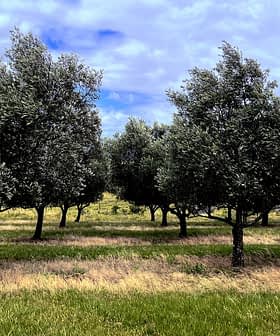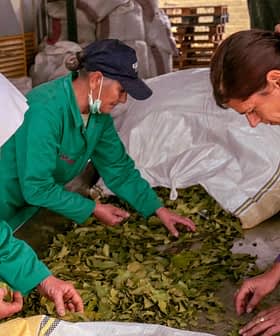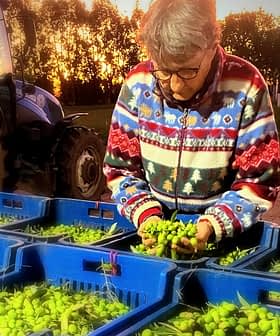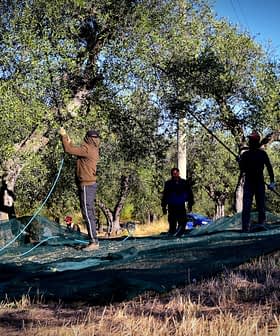A Hobby Grower’s Guide to the Olive Harvest
Harvesting olives at the right moment of maturity and bringing them to the mill within 24 hours are a few tips hobby growers can follow to yield extra virgin olive oil.
 15.4K reads
15.4K readsCalifornia’s olive harvesting season runs from September through November, with the best time to pick olives varying depending on the cultivar and intended use. Green olives should be harvested before they fully ripen, while black olives are picked when fully mature, with different varieties having distinct ripening times.
California’s olive harvesting season runs from September through November, but for hobby growers, it is not always clear exactly when the best moment to harvest has arrived.
Several factors influence the timing of olive picking, which varies depending on the cultivar and intended use.
As olives ripen, their color changes from green to yellow-green, straw-yellow, rose-red, red-brown, and dark red or purplish black. Green olives must be harvested before they fully ripen, while black olives are picked when fully mature.
See Also:How Olives Are Processed Into OilTo gather green olives, look for the right hue. They should be mostly green with a slight blush. The flesh should be firm, and the mature green-ripe olive should release a creamy white juice when squeezed.
Black olives are picked when they have turned fully dark red, purple or black. The precise color varies depending on the variety but is often three to four months after the green ripe stage.
According to Deep Green Permaculture, mature dark olives bruise easily and need to be handled with care. The mature dark olives exude a reddish-black liquid when squeezed.
Different olive varieties have distinct ripening times, with some maturing earlier and some later. The varieties are defined by their seasonal ripening. ‘Early season’ is often ready in late summer; ‘mid-season’ matures in mid-autumn; and ‘late-season’ in late autumn.
“Pick olives just before milling,” Mary Louise Bucher, the master miller and owner of Trattore Farms, told Olive Oil Times. “The ideal timing is for olives to go from the tree to the mill the next day or within 48 hours.”
Bucher recommended leaving fallen olives on the ground to produce high-quality table olives and extra virgin olive oil. In addition, olives should be stored in a cool, dark, well-ventilated place before milling.
Charles T. Crohare, owner of The Olivina, agreed. “Growers need to understand the importance of proper picking and storing of olives,” he said. “Olives should be free of olive fruit fly damage and have minimal leaves or twigs. There can be no dirt, pebbles or rocks, as that can damage the mill.”
Samantha Dorsey, the president of McEvoy Ranch, emphasized that olives need to be milled shortly after the harvest to produce extra virgin olive oil, adding that many community mills will not accept olives harvested days beforehand and refrigerated.
“Olives picked too far in advance will not fare well and may not meet the quality standards,” she said. “We are very selective regarding the quality of olives going into our blend.”
Millers advise checking in advance with the mill in each area. Each mill has unique guidelines and particular quality standards for what they will accept.
Growers who know these preferences in advance can take extra precautions. This includes careful picking, proper handling, correct storage and select timing.
Diligence in harvesting not only can create exceptional olive oil but also can prevent disappointments, such as having olives rejected at the mill.
Picking olives from trees requires care and proper handling. To gather olives, experts advise using proper tools such as gloves, collection containers, pruning shears – called secateurs – and a plastic olive hand rake.
Professional growers recommend placing tarps under the olive trees. If using a rake, the process includes gently dislodging the olives from the tarp.
Although hand-picking olives is more time-consuming, it has distinct advantages. One advantage is that it avoids olive bruising, which many growers find well worth the extra effort.
Some myths about olive harvesting can be the source of significant problems. Growers new to olive harvesting often believe it is a good idea to let the olives fall on their own, which seems like a harmless assumption because it sounds like a natural part of the process.
However, this method is not conducive to producing high-quality extra virgin olive oil because the olives generally fall from the branches after they have become overripe and lost many of the natural compounds that give them their health benefits and organoleptic properties.
Hand-harvesting is convenient when gathering olives on small trees that are not too tall. To pick green olives, shears may be used to cut olive clusters, while avoiding bruising the fruit. To pick black olives by hand, gently grasp and twist the fruit to release it from the stem.
According to Gardening Know How, the earlier olives are harvested, the more bitter the flavor. As olives mature, the flavor softens or mellows.
Before deciding when to harvest, it is helpful to know whether the olives will be preserved in brine or pressed into oil. This way, hobby growers can make appointments at a local mill or take the necessary steps to prepare the brine ahead of time and enjoy the fruits of their labor.
Know the Basics
Things to know about olive oil, from the Olive Oil Times Education Lab.
Extra virgin olive oil (EVOO) is simply juice extracted from olives without any industrial processing or additives. It must be bitter, fruity and pungent — and free of defects.
There are hundreds of olive varieties used to make oils with unique sensory profiles, just as many varieties of grapes are used in wines. An EVOO can be made with just one variety (monovarietal) or several (blend).
Extra virgin olive oil contains healthy phenolic compounds. Substituting a mere two tablespoons of EVOO per day instead of less healthy fats has been shown to improve health.
Producing high-quality extra virgin olive oil is an exceptionally difficult and costly task. Harvesting olives earlier retains more nutrients and extends shelf life, but the yield is far less than that of fully ripe olives that have lost much of their healthy compounds.
Share this article









